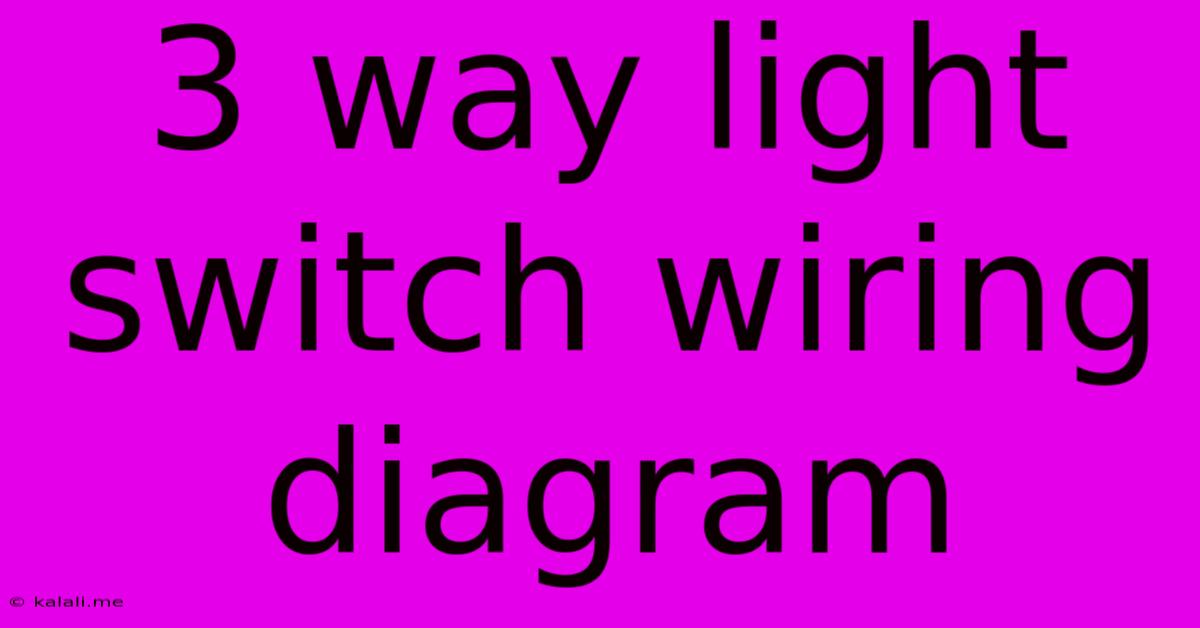3 Way Light Switch Wiring Diagram
Kalali
Jun 10, 2025 · 4 min read

Table of Contents
Decoding the 3-Way Light Switch Wiring Diagram: A Comprehensive Guide
This guide provides a comprehensive understanding of 3-way light switch wiring diagrams, explaining how they work and offering clear instructions for installation and troubleshooting. Understanding this seemingly complex setup is easier than you think! We'll break down the process step-by-step, ensuring you can confidently tackle this common home wiring project.
What is a 3-Way Light Switch?
A 3-way light switch allows you to control a single light fixture from two different locations. This is incredibly useful in hallways, staircases, or any area where switching the light on or off from multiple points is convenient. Unlike a standard single-pole switch, a 3-way switch utilizes a unique wiring configuration involving two switches and three wires. This setup enables the light to be turned on or off regardless of which switch you use.
Understanding the Components:
Before diving into the diagrams, let's identify the key components:
- Light Fixture: The lamp or light you want to control.
- 3-Way Switches (Two): These are special switches with three terminals (rather than two like standard switches). They typically have screws labeled as 'common', 'traveller 1', and 'traveller 2'.
- Power Source: The electrical feed coming from your breaker box.
- Wiring: This includes the power cable, the cables connecting the switches, and the cables connecting the switch to the light fixture. Common wire colors include black (hot), white (neutral), and bare copper (ground).
Common 3-Way Light Switch Wiring Diagrams:
There are several variations depending on your specific wiring and preferences, but here are two common configurations:
Diagram 1: Basic 3-Way Switch Wiring
This diagram illustrates the most straightforward setup:
+-----------------+
| Light Fixture |
+--------+--------+
|
| Black Wire (Hot)
|
+-----------------+ | +-----------------+
| Switch #2 |-------+-------| Switch #1 |
+--------+--------+ | +--------+--------+
| | | |
| Black (Com)|-------+-------| Black (Com)|
| White (Trav)|-------+-------| White (Trav)|
| | | |
+-----------------+ | +-----------------+
|
| White Wire (Neutral)
|
+-----------------+
| Power Source |
+-----------------+
Explanation of Diagram 1:
- Power Source: The black wire from the power source feeds the 'common' terminal of Switch #1.
- Switch #1 to Switch #2: The black wire from the 'traveller 1' terminal of Switch #1 connects to the 'traveller 1' terminal of Switch #2. The white wire from 'traveller 2' on Switch #1 connects to 'traveller 2' on Switch #2. Note: Although white wires typically carry neutral, in this specific application, they are used as travellers. Always ensure proper identification of wires to avoid shorts.
- Switch #2 to Light Fixture: The black wire from the 'common' terminal of Switch #2 connects to the black wire of the light fixture.
- Neutral Wire: The white neutral wire from the power source connects directly to the white neutral wire of the light fixture. This completes the circuit.
- Ground Wire: The bare copper ground wires should be connected together at each junction box and to the light fixture's ground.
Diagram 2: 3-Way Switch with Additional Switch (4-Way Switch)
For controlling a light from three or more locations, a 4-way switch is added to the circuit. This is more complex and requires specialized knowledge of wiring. Always consult a qualified electrician for setups involving 4-way switches.
Troubleshooting:
If your 3-way switch setup isn't working, check the following:
- Loose Connections: Ensure all wire connections are secure and tightly fastened.
- Incorrect Wiring: Double-check the wiring against the diagram, paying close attention to the traveler wires.
- Faulty Switches: Test the switches to ensure they're functioning correctly.
- Blown Fuse or Tripped Breaker: Check your breaker box for any tripped breakers or blown fuses.
Safety Precautions:
- Always turn off the power at the breaker box before working with electrical wiring.
- If you are not comfortable working with electricity, consult a qualified electrician.
- Use appropriate safety equipment, such as insulated screwdrivers and non-conductive gloves.
This guide provides a foundational understanding of 3-way light switch wiring diagrams. Remember to prioritize safety and consult a professional if you're unsure about any aspect of the installation. By carefully following these instructions and diagrams, you can successfully install and troubleshoot your 3-way light switch system.
Latest Posts
Latest Posts
-
Which Of The Following Vitamins Is Water Soluble
Jun 12, 2025
-
What Is The Unit For Wavelength
Jun 12, 2025
-
Transformer Works On The Principle Of
Jun 12, 2025
-
Which Colour Of The Rainbow Has The Shortest Wavelength
Jun 12, 2025
-
Maslows Hierarchy Of Needs And Herzbergs Theory
Jun 12, 2025
Related Post
Thank you for visiting our website which covers about 3 Way Light Switch Wiring Diagram . We hope the information provided has been useful to you. Feel free to contact us if you have any questions or need further assistance. See you next time and don't miss to bookmark.